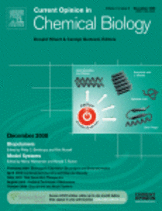Following polypeptide folding and assembly with conformational switches
Pagel, K.; Koksch, B.* – 2008
Conformational transitions are a crucial factor in the vast majority of protein misfolding diseases. In most of these cases, the change in conformation is accompanied by the formation of insoluble aggregates, which often precludes a detailed characterization at the molecular level. Therefore, much effort has been put into the development of simplified, easy-to-synthesize peptide models that can be used to elucidate the molecular processes that underlie the conformational switch. For a design to be successful, two, sometimes concomitantly fulfilled, requirements are of importance. First, it is essential to create inherent structural ambiguity. This is usually achieved by combining the most prominent characteristics of different folds within a consensus sequence. Second, a stimulus-sensitive functionality that responds to alterations in the environment, such as pH, ionic strength or the presence of metal ions, is often needed to control structural conversion and to shift the equilibrium in either direction.
Cover picture: Curr. Opin. Chem. Biol. 2008, 12(6).







